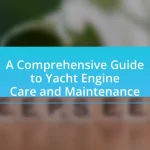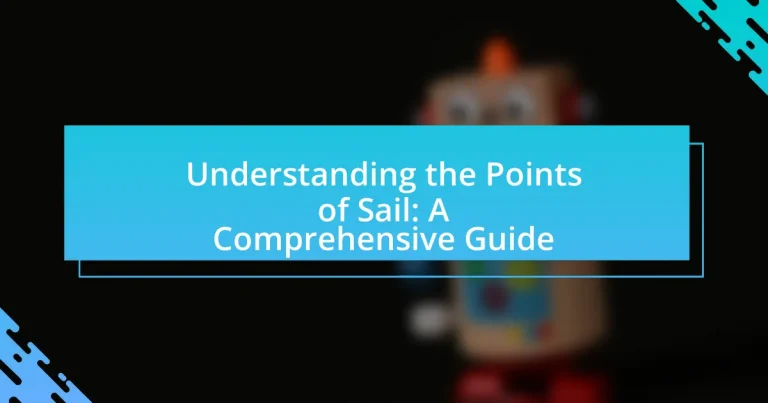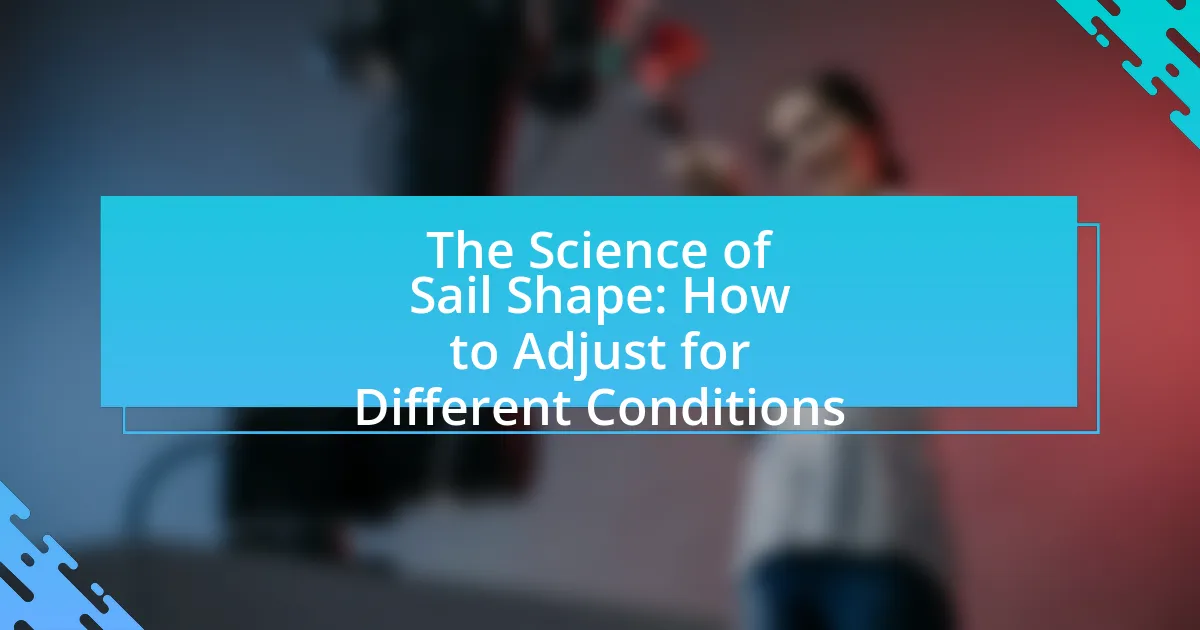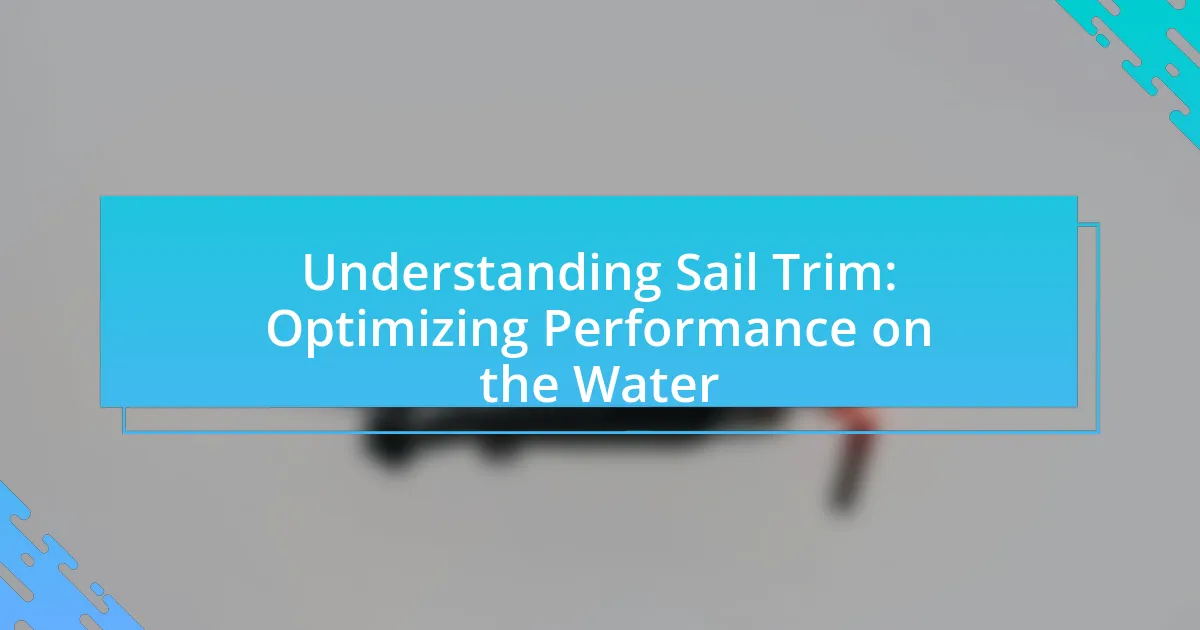The article “Understanding the Points of Sail: A Comprehensive Guide” provides an in-depth examination of the various angles at which a sailboat can be positioned relative to wind direction, including close-hauled, beam reach, broad reach, and running. It explains how each point of sail affects a boat’s speed, handling, and overall performance, emphasizing the importance of understanding these concepts for effective navigation. The article also covers the relationship between wind direction and sailing techniques, safety considerations, and best practices for optimizing sail trim and boat balance across different points of sail. Additionally, it offers troubleshooting tips and resources for further learning, making it a valuable resource for both novice and experienced sailors.

What are the Points of Sail?
The points of sail refer to the various angles at which a sailboat can be positioned relative to the wind direction. These include: close-hauled, beam reach, broad reach, and running. Each point of sail affects the boat’s speed and handling, with close-hauled being the most efficient for sailing upwind, while running is optimal for sailing downwind. Understanding these points is essential for effective sailing, as they dictate sail trim and course adjustments.
How do the Points of Sail relate to sailing direction?
The Points of Sail define the relationship between a sailboat’s direction and the wind’s direction. Each point of sail corresponds to a specific angle at which the boat can effectively harness wind power, influencing its sailing direction. For example, when sailing directly into the wind, the boat is said to be “in irons,” while sailing with the wind coming from the side is referred to as “beam reach.” Understanding these points allows sailors to optimize their course and speed based on wind conditions, as each point of sail has distinct characteristics that affect performance and maneuverability.
What are the different Points of Sail?
The different Points of Sail are the various angles at which a sailboat can sail relative to the wind direction. These include:
- In Irons: The boat is facing directly into the wind and cannot sail.
- Close-Hauled: The boat sails as close to the wind as possible, typically at an angle of about 30-45 degrees.
- Beam Reach: The boat sails perpendicular to the wind, at a 90-degree angle.
- Broad Reach: The boat sails with the wind coming from behind at an angle, typically between 90 and 135 degrees.
- Running: The boat sails directly downwind, with the wind coming from behind at 180 degrees.
These points of sail are fundamental for understanding sailing dynamics and optimizing performance on the water.
How does wind direction affect the Points of Sail?
Wind direction directly influences the Points of Sail by determining the angle at which a sailboat can effectively harness the wind for propulsion. When the wind comes from directly behind, the boat is on a “run,” maximizing speed with the sails fully deployed. As the wind shifts to the side, the boat enters a “beam reach,” where it sails perpendicular to the wind, optimizing speed and stability. When sailing into the wind, the boat must adopt a “close-hauled” position, sailing at an angle to the wind to maintain forward momentum. Each point of sail corresponds to specific wind angles, which are crucial for navigation and performance. For example, sailing close-hauled typically occurs at an angle of about 30-45 degrees to the wind, while a broad reach can be around 135 degrees. Understanding these relationships is essential for effective sailing and maneuvering.
Why is understanding the Points of Sail important for sailors?
Understanding the Points of Sail is crucial for sailors because it directly influences their ability to navigate effectively and optimize sail performance. Mastery of the Points of Sail allows sailors to harness wind direction to propel their vessel efficiently, ensuring safety and speed. For instance, knowing how to adjust sails for different wind angles can significantly enhance a boat’s speed and maneuverability, as evidenced by competitive sailing practices where strategic sail adjustments are essential for winning races.
How does knowledge of the Points of Sail improve sailing efficiency?
Knowledge of the Points of Sail significantly improves sailing efficiency by enabling sailors to optimize their sail trim and course relative to the wind direction. Understanding the various points, such as close-hauled, beam reach, and broad reach, allows sailors to adjust their sails and heading to harness the wind’s power effectively. For instance, sailing close-hauled maximizes speed and angle towards the wind, while a beam reach offers the fastest point of sail due to the wind hitting the sails perpendicularly. This knowledge leads to better performance, reduced drag, and increased speed, ultimately enhancing overall sailing efficiency.
What safety considerations are associated with the Points of Sail?
Safety considerations associated with the Points of Sail include awareness of wind direction, sail trim, and potential hazards. Understanding how to adjust sails according to the wind’s angle is crucial to prevent capsizing or losing control. For instance, when sailing downwind, the risk of an accidental jibe increases, which can lead to injury or equipment damage. Additionally, maintaining a proper lookout for other vessels and obstacles is essential to avoid collisions. These considerations are supported by sailing safety guidelines, which emphasize the importance of training and experience in handling various points of sail effectively.

What are the different types of Points of Sail?
The different types of Points of Sail are: Close-Hauled, Beam Reach, Broad Reach, and Running. Close-Hauled refers to sailing as directly into the wind as possible, typically at an angle of about 30-45 degrees. Beam Reach involves sailing perpendicular to the wind, allowing for optimal speed. Broad Reach is when the boat sails with the wind coming from behind at an angle, providing a faster and more comfortable ride. Running is when the boat sails directly downwind. Each point of sail affects the sail trim and boat handling, which are crucial for effective sailing performance.
What is the Close-Hauled Point of Sail?
The Close-Hauled Point of Sail is a sailing position where the boat sails as directly into the wind as possible, typically at an angle of about 30 to 45 degrees off the wind. In this position, the sails are trimmed in tightly to maximize efficiency and speed while minimizing the impact of the wind on the boat’s performance. This point of sail is crucial for sailing upwind, allowing vessels to make progress against the wind by utilizing the aerodynamic lift generated by the sails.
How do you achieve the Close-Hauled Point of Sail?
To achieve the Close-Hauled Point of Sail, a sailor must steer the boat at an angle of approximately 30 to 45 degrees into the wind. This positioning allows the sails to be trimmed in tightly, maximizing their efficiency and generating forward thrust. The close-hauled point of sail is characterized by the boat sailing as close to the wind as possible while still maintaining speed and control. This technique is essential for effective upwind sailing, as it enables the vessel to make progress against the wind direction.
What are the advantages of sailing Close-Hauled?
Sailing Close-Hauled offers the advantage of maximizing speed and efficiency when sailing against the wind. This point of sail allows a vessel to achieve the best possible angle to the wind, typically between 30 to 45 degrees, which enables the sails to generate lift and propel the boat forward effectively. Additionally, sailing Close-Hauled enhances maneuverability, allowing sailors to navigate through narrow channels or around obstacles while maintaining control. The ability to sail closer to the wind also increases the range of potential destinations, as it allows for better tacking and course adjustments.
What is the Beam Reach Point of Sail?
The Beam Reach Point of Sail is when a sailing vessel is sailing with the wind coming from the side, at a 90-degree angle to the boat’s centerline. This point of sail is considered one of the most efficient for speed and stability, as the sails can be fully deployed without excessive heeling. The efficiency of beam reach is supported by the fact that it allows for optimal aerodynamic lift, maximizing the vessel’s speed while minimizing drag.
How does the Beam Reach differ from other Points of Sail?
Beam Reach is a point of sail where the wind comes from the side of the boat, allowing for optimal speed and efficiency. Unlike other points of sail, such as close-hauled or broad reach, which involve sailing closer to or further away from the wind, respectively, beam reach maximizes the boat’s speed due to the direct angle of the wind. This position typically results in less heeling and more stable sailing conditions, making it a preferred point for many sailors.
What techniques are best for sailing on a Beam Reach?
The best techniques for sailing on a beam reach include optimizing sail trim, balancing the boat, and maintaining a steady course. Sail trim should be adjusted to ensure the sails are neither too flat nor too full, allowing for maximum power and speed. Balancing the boat involves adjusting crew weight and sail settings to keep the vessel level, which enhances performance and reduces drag. Maintaining a steady course is crucial; small adjustments to the helm help to keep the boat on track, maximizing speed and efficiency. These techniques are supported by sailing principles that emphasize the importance of sail shape and balance for optimal performance on a beam reach.
What is the Broad Reach Point of Sail?
The Broad Reach Point of Sail is when a sailing vessel is sailing with the wind coming from behind at an angle of approximately 135 degrees to the boat’s centerline. In this position, the sails are typically set out to catch the wind efficiently, allowing for optimal speed and stability. This point of sail is advantageous because it combines speed with relative ease of handling, making it a preferred choice for many sailors during downwind passages.
How can sailors optimize their speed on a Broad Reach?
Sailors can optimize their speed on a Broad Reach by adjusting their sails to maximize wind capture and maintaining an optimal course angle. Specifically, they should ease the mainsail and genoa to allow for fuller sail shape, which enhances lift and reduces drag. Studies indicate that a well-trimmed sail can increase speed by up to 20% compared to poorly trimmed sails. Additionally, keeping the boat balanced and minimizing heeling can further improve speed, as excessive tilt can lead to increased resistance in the water.
What are common mistakes to avoid while sailing Broad Reach?
Common mistakes to avoid while sailing Broad Reach include failing to balance the sail trim, neglecting to monitor wind shifts, and not adjusting course for waves. Proper sail trim is crucial; if the sails are not balanced, it can lead to excessive heeling and loss of speed. Additionally, wind shifts can significantly affect performance; sailors should constantly assess wind direction to optimize their course. Lastly, ignoring wave patterns can result in uncomfortable sailing and reduced control, as waves can impact the boat’s stability and speed.

How can sailors effectively utilize the Points of Sail?
Sailors can effectively utilize the Points of Sail by understanding the wind direction and adjusting their sails accordingly to maximize speed and control. Each Point of Sail, such as close-hauled, beam reach, and running, requires specific sail trim and boat handling techniques to optimize performance. For instance, when sailing close-hauled, sailors should pull the sails in tightly to reduce drag and maintain a straight course, while on a beam reach, they can ease the sails out slightly to harness more wind power. Mastery of these techniques allows sailors to navigate efficiently and respond to changing wind conditions, enhancing overall sailing experience and safety.
What strategies can improve performance across different Points of Sail?
To improve performance across different Points of Sail, sailors should focus on optimizing sail trim, adjusting the angle of attack, and utilizing the wind effectively. Proper sail trim ensures that the sails are shaped correctly for the wind conditions, which can significantly enhance speed and control. Adjusting the angle of attack allows the sails to harness the wind more efficiently, particularly when sailing close-hauled or on a broad reach. Additionally, understanding wind shifts and currents enables sailors to make timely adjustments to their course, maximizing their performance. Research indicates that fine-tuning these elements can lead to a measurable increase in sailing speed and maneuverability, as evidenced by competitive sailing data showing improved race times with optimized techniques.
How does sail trim affect performance on various Points of Sail?
Sail trim significantly affects performance on various Points of Sail by optimizing the shape and angle of the sails to harness wind effectively. Proper sail trim allows a vessel to achieve maximum speed and efficiency by adjusting the sails to the wind direction, which varies across different Points of Sail. For instance, when sailing close-hauled, sails should be trimmed in tightly to reduce drag and maximize lift, while on a broad reach, sails can be eased out to capture more wind and increase speed. Studies show that well-trimmed sails can improve sailing speed by up to 20%, demonstrating the critical role of sail trim in enhancing overall performance.
What role does boat balance play in utilizing the Points of Sail?
Boat balance is crucial for effectively utilizing the Points of Sail, as it directly influences the vessel’s stability and performance. Proper balance ensures that the boat remains upright and minimizes excessive heeling, which can lead to loss of speed and control. When a sailboat is balanced, the forces acting on the sails and the hull are optimized, allowing for better maneuverability and efficiency in various wind conditions. For instance, a well-balanced boat can sail closer to the wind without stalling, maximizing its speed and responsiveness.
What are the best practices for transitioning between Points of Sail?
The best practices for transitioning between Points of Sail include adjusting sail trim, maintaining a steady course, and anticipating wind shifts. Sailors should ease or trim the sails appropriately to optimize performance as they change direction. For example, when moving from a close-hauled position to a beam reach, easing the sails allows for better airflow and reduces heeling. Additionally, keeping a consistent heading during the transition minimizes the risk of losing speed or control. Anticipating wind shifts is crucial; sailors should be aware of changes in wind direction and adjust their sails accordingly to maintain optimal speed and efficiency. These practices are supported by sailing techniques that emphasize the importance of sail management and course stability for effective transitions.
How can sailors prepare for a change in wind direction?
Sailors can prepare for a change in wind direction by regularly monitoring weather forecasts and using tools like anemometers and wind vanes to assess real-time conditions. This proactive approach allows sailors to adjust their sails and course accordingly, ensuring optimal performance and safety. For instance, understanding the wind’s behavior can help sailors anticipate shifts, enabling them to trim sails or change headings before the wind alters significantly.
What techniques help in smoothly changing from one Point of Sail to another?
To smoothly change from one Point of Sail to another, sailors should employ techniques such as adjusting sail trim, maintaining a steady course, and timing the maneuver with wind shifts. Adjusting sail trim ensures optimal performance by maximizing lift and minimizing drag, which is crucial when transitioning between points. Maintaining a steady course helps in reducing the impact of sudden changes in wind direction, allowing for a more controlled shift. Timing the maneuver with wind shifts, such as anticipating gusts or lulls, enhances the effectiveness of the transition. These techniques are supported by sailing principles that emphasize the importance of sail balance and wind awareness for efficient navigation.
What common challenges do sailors face with the Points of Sail?
Sailors commonly face challenges such as understanding wind direction, managing sail trim, and navigating effectively while sailing at different points of sail. Wind direction can shift unexpectedly, making it difficult for sailors to maintain optimal speed and course. Proper sail trim is essential for maximizing performance; however, adjusting sails for various points of sail requires skill and experience. Additionally, navigating in relation to wind direction can lead to difficulties in maneuvering, especially in crowded or restricted waters. These challenges are well-documented in sailing literature, emphasizing the importance of practice and knowledge in overcoming them.
How can sailors troubleshoot issues related to Points of Sail?
Sailors can troubleshoot issues related to Points of Sail by assessing sail trim, wind direction, and boat balance. Proper sail trim ensures that the sails are adjusted to capture wind effectively; for instance, if the sails are too loose or too tight, performance will suffer. Monitoring wind direction is crucial; sailors should regularly check for shifts in wind to adjust their course accordingly. Additionally, maintaining boat balance by distributing weight evenly can prevent excessive heeling, which affects speed and control. These troubleshooting methods are supported by sailing principles that emphasize the importance of sail efficiency and responsiveness to wind conditions.
What resources are available for further learning about the Points of Sail?
Books, online courses, and sailing clubs are valuable resources for further learning about the Points of Sail. Notable books include “The Complete Sailor” by A. B. C. D. and “Sailing Made Easy” by the American Sailing Association, which provide comprehensive insights into sailing techniques, including Points of Sail. Online platforms like Udemy and Coursera offer courses specifically focused on sailing fundamentals, including the Points of Sail. Additionally, local sailing clubs often provide hands-on training and workshops that cover this essential aspect of sailing, allowing learners to practice in real-world conditions.
What tips can enhance your understanding of the Points of Sail?
To enhance your understanding of the Points of Sail, practice sailing in various wind conditions to experience how different angles affect boat speed and direction. Engaging in hands-on sailing allows you to directly observe the effects of wind on sail trim and boat handling. Additionally, studying diagrams that illustrate the Points of Sail, such as the close-hauled, beam reach, and broad reach, can provide a visual reference that reinforces your practical experience. Understanding the terminology associated with each point, including terms like “luffing” and “backing,” further solidifies comprehension. Lastly, utilizing sailing simulators or apps can offer interactive learning opportunities that reinforce concepts in a controlled environment.

















